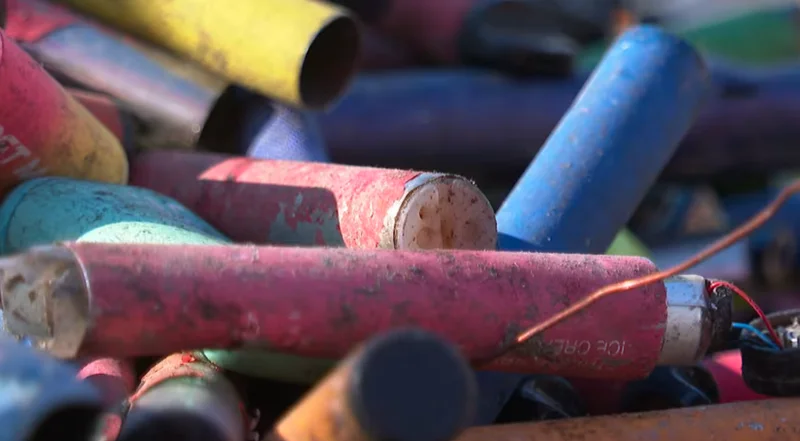The electronic cigarette that refuses to go “Puff”
Vaping devices – especially single-use ones – and products based on heated tobacco represent a new source of pollution. No satisfactory solution for recycling them exists, so most end up in the environment.
They look like fluorescent markers. Or USB keys. The new generation of electronic cigarettes, frequently called “puffs”, no longer has much in common with the first devices equipped with heavy nicotine liquid reservoirs that arrived on the market almost 20 years ago.
The electronic cigarette was devised in 2003 under the aegis of Chinese pharmacist Hon Lik.[1] However, the devices first entered western markets in 2008. They were then mainly manufactured by small independent groups. Equipped with refillable nicotine tanks, they could be recharged with a USB cable.
Initially sceptical about this new form of nicotine consumption, the tobacco giants quickly grasped its commercial potential. In 2012, Lorillard bought the American blu eCigs for USD 135 million.[2] Altria, for its part, acquired Green Smoke for USD 110 million in 2014 and put its own e-cigarette on the market under the name MarkTen.[3] Shortly after, other tobacco companies in turn invested – British American Tobacco with Vuse, Japan Tobacco with Logic, and Imperial Brands with Blu.[4]

Starting in 2015, however, a new competitor called Juul began to quickly gain market share. Unlike its predecessors, this new e-cigarette was equipped with a single-use cartridge containing nicotine salts. Once the liquid ran out, the cartridge had to be thrown away and replaced with a new one. Juul arrived on the Swiss and European markets around 2018.[5]
Philip Morris International remained in the background for a long time. The Lausanne-based firm chose to focus instead on heated-tobacco products, bringing the iQos to market in 2014. They only entered the e-cigarette market in 2018 with the iQos Mesh, which became Veev in 2020[6].
But a newcomer was preparing to shake up this ecosystem again. Launched in 2019 in the United States, Puff Bar, an invention of the California start-up Cool Clouds Distribution and subsequently sold to the Chinese DS Technology Licensing, was entirely disposable.[7] Since it cannot be refilled or reloaded, this e-cigarette is intended to be thrown away after a single use.
Arriving in Switzerland in 2020, it quickly experienced stratospheric growth and today dominates the market, alongside the many imitations that have emerged, such as Elf Bar, Geek Bar, and Happy Puff.[8] These disposable vapes come in 139 flavours, including mango, lychee ice, and whiskey. Most contain synthetic nicotine, and the size of their e-liquid tank generally allows them to generate 600 puffs of aerosol, but some products can reach 10,000 or even 16,000 puffs. Legal standards certainly exist to limit the capacity of these tanks to 2 ml – the equivalent of 600 puffs – but these are largely ignored and most products on the Swiss market exceed these standards, making them illegal.[9] Their prices range from CHF 5 to CHF 20 in Switzerland.[10]
Here too, the tobacco giants have not stood idly by. In 2022, British American Tobacco launched Vuse Go, a disposable version of its e-cigarette, while Philip Morris International brought to market a similar product called Veeba.[11] However, an estimated 95% of the world's production of disposable e-cigarettes is of Chinese origin, with a concentration in the city of Shenzen. These Chinese products are very competitive because they are produced at a very low cost and with no quality standards.[12]
There is scant data on the number of these e-cigarettes – disposable or not – that end up in the environment. At most we know that 51% of young Juul users in the United States throw them in the trash, 17% put them in recycling bins – which are not equipped to receive them – and 10% litter them into the environment, according to a study carried out in 2020.[13] A survey also revealed that the lithium contained in e-cigarette batteries thrown away over the course of a year in the United Kingdom would be enough to equip 1,200 electric vehicles.[14]

These devices are extremely polluting. “They contain several toxic and non-biodegradable substances: hard plastic, which is one of the slowest materials to degrade; leftover nicotine fluid, whose effects on the environment are still largely unknown; and batteries containing harmful heavy metals such as lithium, cobalt, and nickel,” explains Debbie Sy, in charge of strategic affairs for the Global Center for Good Governance in Tobacco Control.
These effects are multiplied in the case of disposable e-cigarettes. “People throw them away after just one use, which has the effect of creating a mountain of avoidable waste,” notes Thomas Novotny, a public health and environmental specialist at the University of San Diego (US). This makes them even more damaging than other single-use plastics such as straws, bags, or disposable cutlery, which are now banned in many jurisdictions, including the European Union.
The situation is not much better on the heated tobacco front. The iQos is a device made of aluminum and plastic that contains a lithium-ion battery. The blade that heats the tobacco is made of platinum and gold covered with a layer of ceramic. Here too we are dealing with non-biodegradable materials.[15]
Whether e-cigarettes or heated tobacco products, the risk of fire is extremely high. When lithium-ion batteries are included in household or recyclable waste, they are at risk of being struck or crushed, which can damage the separator between the cathode and electrode, causing a short circuit and a fire or explosion.[16]
Several landfills in the United States have experienced this, like that of Brown County, Wisconsin.[17] In 2017, a recycling truck exploded in Northamptonshire, UK, due to an electric battery.[18] Switzerland is also affected. In just two months in the summer of 2023, 10 waste-sorting centres suffered fires caused by lithium-ion batteries, including those in Geneva, Gland, and Cressier.[19]
Fires sometimes happen mid-flight. In May 2023, an e-cigarette caught fire on a plane flying from Geneva to Amsterdam, slightly injuring passengers. The plane had to turn back.[20]
Despite these dangers, no solution currently exists for disposing of vapes in an environmentally responsible way. “Recycling them is very complex because of their many components – plastics, batteries, nicotine juice – which are difficult to separate,” explains Chris Bostic, public policy director for Action on Smoking and Health (ASH).
In the United States, placing e-cigarettes in plastic recycling bins is illegal because they contain lithium-ion batteries and nicotine liquid residue, considered a toxic waste by the Environmental Protection Agency.[21] Due to the lack of a solution, most e-cigarettes end up in the trash or are littered into the environment.
Consumers are faced with contradictory messages in some countries. In the United Kingdom, retailers who sell more than GBP 100,000 worth of e-cigarettes per year are obliged to take them back for delivery to an electronics recycling center, but few of them seem to be aware and take appropriate action, often rather just placing them in battery recycling bins.[22]
In Switzerland, the SENS eRecycling foundation, which counts Philip Morris International among its partners, introduced a recycling system for single-use e-cigarettes in July 2023 that also covers reusable e-cigarettes and heated tobacco products. “Consumers can bring their used products back to the point of sale, where they are put into bags that we provide. These bags are taken to a post office for distribution to an electronics recycling center – based on the model of Nespresso coffee capsules,” explains Sabrina Bjöörn, who runs this initiative.

The costs are covered by e-cigarette manufacturers through a recycling tax added to the sale price of e-cigarettes. However, she specifies that the process does not currently allow the entire device to be recycled. “The battery and electronic components are recovered but the plastic is burned,” she says. The system also remains voluntary. “We estimate that about 5% of single-use e-cigarettes are currently being recycled,” she says.
Faced with the difficulty of disposing of these devices in an environmentally friendly way, some governments have started to ban them. The sale of e-cigarettes is prohibited in 34 countries, including Mexico, Brazil, Norway, India, Turkey, and Thailand. At the start of 2024, the United Kingdom, where 1.3 million single-use e-cigarettes are thrown away every week, announced that it would in turn ban them. Belgium is the first EU country to also take this step.
In 87 other states, e-cigarette sales are subject to restrictions, such as a ban on selling them online or on offering certain flavours. In Australia, the purchase of e-cigarettes is only possible at a pharmacy with a prescription as part of a process to stop smoking.
Switzerland has fallen behind in this regard. Some cantons have banned the sale of e-cigarettes to minors and this measure will be introduced at the federal level in 2024 as part of the new law on tobacco products. But no plans currently exist to ban them for all ages.
[1] https://www.britannica.com/topic/e-cigarette
[2] https://www.bbc.co.uk/news/magazine-20583902
[5] Ibidem
[7] https://tobaccoreporter.com/2021/11/01/puff-bar-ceos-profiled/
[10] Ibidem
[11] Ibidem
[12] https://apnews.com/article/vaping-elf-bar-ecigarettes-china-teens-77033584983ad47fc5795baa46b4705e
[15] https://iris.who.int/bitstream/handle/10665/354579/9789240051287-eng.pdf?sequence=1
[18] https://www.letsrecycle.com/news/battery-causes-explosion-waste-truck/
[21] https://www.thelancet.com/journals/lanres/article/PIIS2213-2600(22)00187-4/fulltext
[24] https://www.dailymail.co.uk/health/article-12886003/vape-divide-cigarettes-ban-countries-policy.html